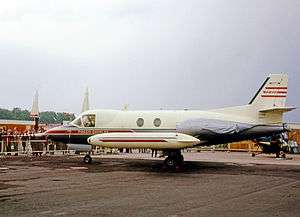Piaggio PD.808
| PD.808 | |
|---|---|
 | |
| The prototype Piaggio PD.808 at the 1966 Hanover Air Show wearing Italian Air Force markings | |
| Role | Business & military jet |
| Manufacturer | Piaggio Aero |
| Designer | Douglas Aircraft Company |
| First flight | 29 August 1964 |
| Introduction | November 1966 |
| Primary user | Italian Air Force |
| Number built | 24 |
| Unit cost |
$350,000-$400,000 in 1961[1] |
The Piaggio PD.808 was designed by the Douglas Aircraft Company of Long Beach, California, as a business jet.
Development and history
No orders were received by Douglas, and the complete project was bought by Piaggio Aero, which flew the first prototype in August 1965. Piaggio also failed to secure any worthwhile commercial interest, but a few examples were taken by the Italian Air Force.
Only 24 examples of this type, with low-set wings and aft-mounted turbojet engines, were produced, and 22 of these went to the Italian Air Force. The first aircraft were configured for the utility role, but the last six aircraft were completed as electronic platforms with cabin accommodation for specialist electronic intelligence equipment and its three operators.
Variants
- PD-808VIP: VIP transport.
- PD-808TA: navigation trainer.
- PD-808RM (radiomisure): radio calibration.
- PD-808GE (guerra elettronica): Electronic warfare aircraft. The version PD-808GE1 entered service in 1972, the PD-808GE2 in 1977.
- PD-808TF: Proposed turbofan-powered version. Not built.
Operators
- Italian Air Force operated 22 Piaggio PD.808 from 1970 until 2003[2]
Aircraft on display
- Italy
- MM62015 – PD-808GE on static display in Lucca, Tuscany. It was previously operated by the Italian Air Force.[3]
Specifications (PD.808)
Data from ,[4] Jane's Aircraft Recognition Guide[5]
General characteristics
- Crew: 1/2
- Capacity: 6-10 pax
- Wingspan: 13.2 m (43 ft 4 in) over tip tanks
- Height: 4.8 m (15 ft 9 in)
- Wing area: 20.9 m2 (225 sq ft)
- Aspect ratio: 6.25
- Airfoil: root:DES 0010-1·1-40/11° (modified) ;DES 0008-1·1-40/9° (modified)
- Empty weight: 4,830 kg (10,648 lb)
- Max takeoff weight: 8,165 kg (18,001 lb)
- Fuel capacity: 1,935 l (511 US gal; 426 imp gal) in wing integral tanks plus 1,792 l (473 US gal; 394 imp gal) in 2 wing-tip tanks
- Powerplant: 2 × Rolls Royce Viper Mk526 turbojet engines
Performance
- Maximum speed: 852 km/h (529 mph; 460 kn) at 5,945 m (19,505 ft)
- Maximum speed: Mach 0.85
- Cruise speed: 722 km/h (449 mph; 390 kn) at 1,250 m (4,100 ft)
- Stall speed: 167 km/h (104 mph; 90 kn) at 5,902 kg (13,012 lb) landing weight
- Never exceed speed: 788 km/h (490 mph; 425 kn) (0.85M above 4,260 m (13,980 ft))
- Range: 2,128 km (1,322 mi; 1,149 nmi) with max fuel, 381 kg (840 lb) payload and 45 min fuel reserve
- Service ceiling: 13,715 m (44,997 ft)
- Rate of climb: 27.5 m/s (5,410 ft/min) at sea level and 7,176 kg (15,820 lb)
- Wing loading: 390.6 kg/m2 (80.0 lb/sq ft)
- Thrust/weight: 0.0036 kN/kg (0.37 lbf/lb)
References
| Wikimedia Commons has media related to Piaggio PD.808. |
- ↑ Sweeney, Richard L. (August 1961). "Douglas Aircraft Wings for Transport Supersonic and Space". Flying Magazine. Chicago, Ill.: Ziff-Davis Pub. Co. p. 24.
- ↑ "Piaggio PD.808" Aeronautica Italiana
- ↑ "Airframe Dossier - DouglasPD-808, s/n MM62015 AMI, c/r I-PIAY". Aerial Visuals. AerialVisuals.ca. Retrieved 30 May 2017.
- ↑ Taylor, John W.R., ed. (1975). Jane's all the world's aircraft, 1975-76 (66th annual ed.). New York: Franklin Watts Inc. pp. 137–138. ISBN 978-0531032503.
- ↑ Rendall, David (1995). Jane's Aircraft Recognition Guide. Glasgow, UK: HarperCollinsPublishers. p. 505. ISBN 0-00-470980-2.